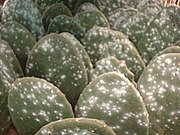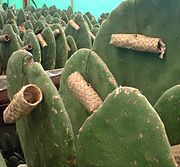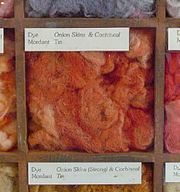Cochineal
Template:Taxobox begin Template:Taxobox image Template:Taxobox begin placement Template:Taxobox domain entry Template:Taxobox regnum entry Template:Taxobox phylum entry Template:Taxobox classis entry Template:Taxobox ordo entry Template:Taxobox familia entry Template:Taxobox genus entry Template:Taxobox species entry Template:Taxobox end placement Template:Taxobox section binomial Template:Taxobox begin synonyms Template:Taxobox synonym entry Template:Taxobox synonym entry Template:Taxobox end synonyms Template:Taxobox end
Cochineal (Dactylopius coccus) is a scale insect in the order of Homoptera, native to tropical and subtropical South America and Mexico. A sesile parasite, it lives primarily on cacti from the genus Opuntia, feeding on moisture in the cacti. The dried bodies of the females or eggs are the main source of carminic acid which is used to make an expensive crimson or carmine red coloured dye primarily used as an food artificial colouring or for cosmetics named after the insect.
After synthetic pigments were invented in late 19th century, natural dye production gradually diminished. However, current health concerns over artificial food additives has renewed the popularity of cochineal dyes; increased demand making cultivation of the insect profitable againTemplate:Mn.
Biology
Cochineals are soft-bodied, flat, oval-shaped scale insects that cluster on cacti plants. The cacti pads are colonised by wingless female insects which are about 5 mm long, the females are sesile and do not move while feeding. They have a beak that penetrates the plant and allows feeding on the plant juices. After mating the fertilised female increases in size and gives a birth to tiny nymphs. The nymphs secrete a waxy white substance over their bodies for protection from water and excessive sun. This substance makes the cochineal insect appear white or grey from the outside. The body of the insect and its nymphs produces a red pigment, which makes the insides of the insect look dark purple. The pigment is based on carminic acid and its purpose is to protect the insect from predators. Adult males are tiny compared to females, males have wings and they only live long enough to fertilise the eggs.Template:Mn Males are seldom observed Template:Mn.
The cochineal disperses in a nymph stage also called the crawler. The juveniles move to a feeding spot and produce long wax filaments. Later they move to the edge of the prickly pear pad where the wind catches the wax filaments and carries the cochineal to a new host. These individuals establish feeding sites on the new host and produce a new generation of cochineal Template:Mn.
Distribution
Cochineals are native to tropical and subtropical South America and Mexico. Cochineals have also been introduced to Spain, Canary Island, Algiers and Australia.
Host cacti

Nowadays there are 150 varieties of nopal cacti, it's possible to cultivate cochineal on almost all of them, best to use is Opuntia indicamil Template:Mn. All of the host plants of the cochineal colonies were identified as species of Opuntia including Opuntia amyclaea, O. indicamil, O. atropes, O. cantabrigiensis, O. brasilienis, O. ficus-indica, O. fuliginosa, O. jaliscana, O. leucotricha, O. lindheimeri, O. microdasys, O. megacantha, O. pilifera, O. robusta, O. sarca, O. schikendantzii, O. stricta, O. streptacantha, and O. tomentosa Template:Mn.
The feeding of the female cochineal often causes damage and sometimes kills the host cactus plant. Immature males while being nymphs feed on a cactus for a short time, and when adult, males cannot feed at all.
Cochineal-laden cacti Opuntia stricta were introduced into Australia to produce cohcineal dye, but the introduction of the cactus had disastrous consequences. By 1925, 250,000 km² of valuable range land was covered by prickly pear cactus. To control the spread of prickly pear cactus in Australia, the cactus moth (Cactoblastis cactorum) was introduced, and by 1930, vast areas of cactus scrub had been denuded by cactus moth larvae. Side effects have caused a havoc: the moth has attacked other species of cacti, some of which are rare and endangered Template:Mn.
Farming

There are two methods of farming, traditional and controlled. The traditional method includes planting already infected pads or infecting existing cacti with cochineal and later harvesting by hand. The controlled method consists in putting small baskets called Zapotec nests on cacti, known to be used in the past centuries. The baskets contain clean, fertile females which leave the nests and settle wherever they like to await insemination by the males. In both cases the cochineal has to be protected from predators, cold and rain. The complete cycle lasts 3 months during which the cacti are kept at a constant temperature of 27 °C. Once the cochineal has finished the cycle, the new cochineal is ready to infest other cacti or to be dried for raw materials Template:Mn.
Several natural enemies can reduce the population of the insect on its cacti hosts. Of all the predators, insects seem to be the most important group. Insects and their larvae such as the weaver worm, pyralid moth (order Lepidoptera), lady bug (Coleoptera), fly, drum worm (Diptera), needle worm (Neuroptera) and ants (Hymenoptera) have been identified. Many birds, domestic rodents, especially rats, and reptiles also are predators of cochineal population. In regions, dependant on cochineal production, pest control measures have to be taken seriously. For small scale cultivation manual methods of control have proved to be the most effective and safe. For large scale cultivation advanced pest control methods have to be developed, including alternative bioinsecticides or traps with pheromones Template:Mn.
Dye
To produce dye from Cochineals, the insects are collected when they are approximately ninety days old. The insects are knocked, brushed or picked from the cacti and placed into bags; it is a highly labor-intensive activity. The insects are gathered by small groups of collectors who sell them to local processors or exporters Template:Mn.
A deep crimson dye is extracted from the Cochineal insect females. Cochineal is used to produce scarlet, orange and other tints of red colour dyes, too. The colouring comes from carminic (kermesic) acid. Cochineal extract natural carminic acid content is usually 19-22% Template:Mn. The insects are killed, by either immersion in hot water (after which they are dried) or by exposure to sunlight, steam, or the heat of an oven. Each method produces a different colour whch is why there is a varied appearance of commercial cochineal. The immersion technique produces grey grains known as grey cochineal Template:Mn. Heating technique produces almost black grains known as black cochineal. The insects must be dried to about 30 per cent of their original body weight before they can be stored without decayingTemplate:Mn. It takes around 155,000 insects to make one kilogram of cochineal.
There are two main forms of cochineal dye, cochineal extract is a colouring made from the raw dried and pulverised bodies of insects and carmine is a more purified colouring made from cochineal. To prepare carmine, the powdered insect bodies are boiled in ammonia or sodium carbonate solution, the insoluble matter is removed by filtering, and alum is added to the clear salt solution of carminic acid to precipitate the red aluminium salt. Purity of colour is ensured by the absence of iron. Stannous chloride, citric acid, borax, or gelatin may be added to regulate the formation of the precipitate. For the shades of purple, lime is added to the alum Template:Mn.
The dried insects and extracts must conform to the buyer’s specification for very low maximum levels of bacteriaTemplate:Mn. Cochineal is produced commercially only in Peru, which produces about 200 tonnes per year Template:Mn, and the Canary Islands, which produces only about 20 tonnes per yearTemplate:Mn. France is believed to be the world’s largest importer of cochineal, but Japan and Italy are also important direct importers. A high proportion of these imports are reexported in processed form, mainly to other developed economiesTemplate:Mn. Recently two new producers have entered the market, Chile and Mexico Template:Mn. As of time of writing in 2005, market price of cochineal is between 50 and 80 USD per kilogramTemplate:Mn, while synthetic raw food colour dyes are available at prices as low as 10-20 USD per kilogram Template:Mn.
History
Cochineal was used by the Aztecs and Mayans. 11 cities conquered by Montezuma in 15th century paid a yearly tribute of 2000 decorated cotton blankets and 40 bags of Cochineal dye each Template:Mn. During the colonial period Mexico was the first country to produce Cochineal for export, Spanish conquistadors introduced the dye from Mexico to Europe during the 17th century. Template:Mn As a product for export, it left the country via Veracruz and entered Europe through Spain, where it was redistributed to different countries, reaching Russia and even Persia Template:Mn. The Mexican city of Oaxaca, Oaxaca, and its hinterland owed much of its prosperity in the 17th and 18th centuries to the cochineal trade. It has since been imported to and cultivated in other locations, such as Peru and the Canary Islands, where it became a lucrative export Template:Mn. In the 18th century the dye industry was so economically important, that it was third highest source of income for Spanish colonies after gold and silver exports.
Recipes for artists' use of carmine appear in many early painting and alchemical handbooks throughout the Middle Ages. Carmine lakes appear frequently in European oil paintings from Michelangelo, François Boucher to Raoul Dufy Template:Mn. The British Army redcoats and the Royal Canadian Mounted Police coats were dyed with cochineal red Template:Mn.
After the Mexican War of Independence in 1810-1821, the Spanish monopoly on cochineal came to an end. The demand for cochineal fell with the appearance on the market of artificial colourants, like alizarin crimson and many other substitute dyes discovered in Europe at the end of the 19th century. The delicate manual labor required for the breeding of the insect could not compete with the modern methods of the new industry and even less so with the lowering of production costs. The “tuna blood” dye stopped being used and trade in cochineal almost totally diminished in a course of the 20th century. The breeding of the cochineal insect has been done mainly for the purposes of maintaining the tradition rather than to satisfy any sort of demand Template:Mn.
In recent years it has become commercially valuable again Template:Mn, because, unlike many commercial synthetic red dyes, it is non-toxic and not carcerogenic (however, some people are allergic to carmine).
Usage

Traditionally cochineal was used for colouring fabrics. During the colonial period, with the introduction of the sheep to South America, the use of cochineal increased, as it provided the most intense colour and it set more firmly on woolen garments than on clothes made of materials of pre Hispanic origin, such as cotton, agave plant fibers or yucca fibers. Once the European market had discovered the qualities of this product, their demand for it increased dramatically. Red carmine became strong competition for the European colorants, such as madder root, kermes, brazilwood, Tyrian purple Template:Mn. as it was used for dyeing the clothes of kings, nobles and the clergy. It was also used for painting handicrafts and tapestries Template:Mn. Cochineal dye coloured wool and cotton is still important material for Mexican folk art and crafts.
Now it is used as a fabric and cosmetics dye and as a natural food colouring, as well as for oil paints, pigments and watercolours. When used as a food additive, the dye must be labelled on packaging labels Template:Mn. Sometimes Carmine is labelled as E120. An unknown percentage of people have been found to have allergies to carmine, ranging from mild cases of hives, to anaphylactic shock. Carmine has been found to cause asthma in some people Template:Mn. Cochineal is one of the colours that the Hyperactive Children's Support Group recommends be eliminated from the diet of hyperactive children.
Cochineal is one of the few water-soluble colourants that resist degradation with time. It is one of the most light and heat stable, resistant to oxidation of all the natural colourants and is even more stable than many synthetic food colors Template:Mn. The water soluble form is used in alcoholic drinks with calcium carmine, the insoluble form, being used in a wider variety of products. Together with ammonium carmine they can be found in meat, sausages, processed poultry products (meat products cannot be coloured in the United States), surimi, marinades, alcoholic drinks, bakery products and toppings, biscuits, desserts, icings, pie fillings, jams, preserves, gelatin desserts, juice beverages, variety of cheddar cheese and dairy products, sauces and sweets. It gives Campari and other Italian apéritifs their colour, tooTemplate:Mn. The average human body consumes one to two drops of carminic acid each year with food Template:Mn.
Carmine is one of the very few pigments considered safe enough for use in eye cosmetics Template:Mn. A significant proportion of insoluble carmine pigment produced annually is used in the cosmetics industry for hair and skin care products, lipsticks, face powders, rouges, and blushes Template:Mn. A bright red dye and the biological stain carmine used in microbiology is often made from the carmine extract, too Template:Mn. The pharmaceutical industry uses cochineal to colour pills and ointments Template:Mn.
Natural carmine dye used in food can render it rather unattractive to vegetarian consumers, and Muslims consider carmine containing food forbidden (haraam), because insects are used in dye production.
References
Template:MnbTemplate:Web reference author
Template:MnbTemplate:Web reference author
Template:MnbTemplate:Web reference author
Template:Mnb"Canary Islands cochineal producers homepage". July 14. {{cite web}}: Check date values in: |date= and |year= / |date= mismatch (help)
Template:MnbTemplate:Web reference author
Template:MnbTemplate:Web reference author
Template:MnbTemplate:Web reference author
Template:Mnb"Cultivation of Cochineal in Oaxaca". Go-Oaxaca Newsletter. July 15. {{cite web}}: Check date values in: |date= and |year= / |date= mismatch (help)
Template:Mnb"Price Quote". July 15. {{cite web}}: Check date values in: |date= and |year= / |date= mismatch (help)
Template:MnbTemplate:Web reference author
Template:MnbTemplate:Web reference author
Template:MnbTemplate:Web reference author
Template:MnbTemplate:Web reference author
